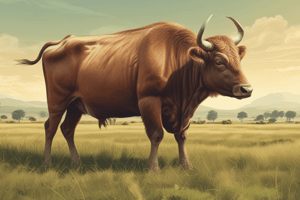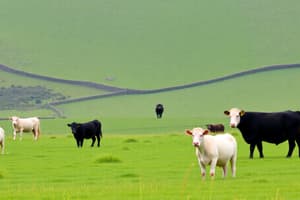Podcast
Questions and Answers
What is the main difference between Rough Mountain/Hill Grazing and Leys in terms of grassland type?
What is the main difference between Rough Mountain/Hill Grazing and Leys in terms of grassland type?
Rough Mountain/Hill Grazing is a permanent grassland, while Leys is a temporary grassland
What is the primary purpose of liming in Rough Mountain/Hill Grazing?
What is the primary purpose of liming in Rough Mountain/Hill Grazing?
To improve soil quality
What is the significance of the reproductive phase in grass growth?
What is the significance of the reproductive phase in grass growth?
Growth slows down in the reproductive phase
How does palatability affect grazing behavior?
How does palatability affect grazing behavior?
What is the main factor influencing the nutritional value of dry matter?
What is the main factor influencing the nutritional value of dry matter?
What is the primary purpose of silage production?
What is the primary purpose of silage production?
Flashcards are hidden until you start studying
Study Notes
Grassland Management
- Permanent grassland on peaty soil can be improved by liming and reseeding
- Temporary grasslands (leys) have variable botanical composition, medium stocking rates, and production levels
Grass Growth Phases
- Vegetative phase: tillers form
- Elongation phase: stem growth
- Reproduction phase: seed head emerges, growth slows down
Grass Quality
- Palatability: measure of grass taste, affects grazing preference and intake
- Productivity: quantity of herbage produced, higher productivity means more available for grazing
- Digestibility: proportion of food assimilated vs. consumed, crucial for livestock nutrition
Dry Matter
- Remaining matter after water removal in food, impacts nutritional value
- Dry Matter Digestibility (DMD): percentage of dry matter digested by animals
- Dry Matter Intake (DMI): amount of feed consumed excluding water content
Seed Selection
- Options: Perennial RyeGrass, Italian RyeGrass, White Clover, Red Clover for different grazing needs
Grazing Methods
- Paddock Grazing, Strip Grazing, Block Grazing, Zero Grazing, Creep Grazing, Mixed Grazing, and Extended Grazing
Livestock Units (LU)
- Measurement for grazing needs, 1 LU = 12 tonnes of herbage annually
Silage and Hay Production
- Silage production: fermentation of grass for preservation, factors like pH, DM%, and DMD% affect quality
- Hay production: dehydration of grass for preservation, inhibits microbial activity
Steps for Silage Production
- Field preparation, cutting at vegetative stage, wilting, chopping, compacting, covering with polythene
Studying That Suits You
Use AI to generate personalized quizzes and flashcards to suit your learning preferences.




